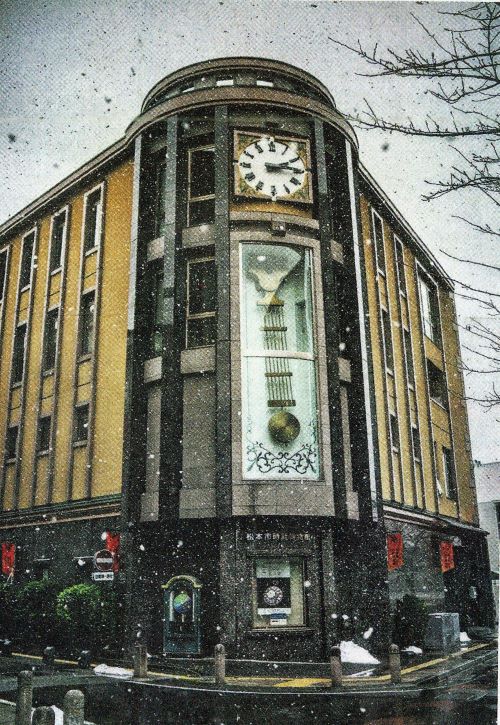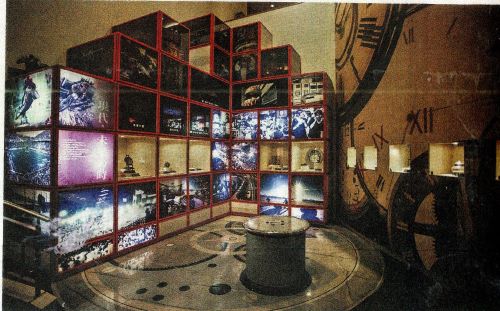






B
���{�s���v������
The New York Times��(2024.04.23)�Ɍf�ڂ��ꂽ���{�s���v�����ق̏Љ�L���ł��B �ʐ^�̌�ɖ{������p�Ζ�ōڂ��܂����B
| BY VIVIAN MORELL | |
 |
|
| ���{�ōł��Â����1�ł��鏼�{�� | |
 |
���{�̎��v������ |
 |
�����ق�800��̎��v�R���N�V�����̈ꕔ��W�� |
 |
�����L���ɂ͑厞�v������ł��܂� |
 |
�����q���̎p�������ǂ����U��q���v |
 |
���W���̌`�������������v |
 |
�\�ߑ��肳�ꂽ�o�H�ɉ����ĕ�������R�₷���ƂŎ��Ԃ𑪂鍁���v |
���{���v�����ق̖{��
A place that keeps time(���Ԃ�����ł���ꏊ) |
|
| The Timepiece Museum in Japan, has a collection of about 800 clocks, with the oldest from the 1400s ( ���{�̎��v�����قɂ́A��800��̎��v����������Ă���A�ŌÂ̂��̂�1400�N��̂��̂ł��B�j | |
| ���� | ���{��� |
There are a lot of reasons to visit Matsumoto, a city at the foot of the Ja;anese Alps in the central refecture of Nagano. |
���쌧�̒��S���A���{�A���v�X�̘[�Ɉʒu���鏼�{��K��闝�R�͂�������܂��B�����̖K��҂́A�����ł��ł��Â�16���I�̏��������A�V�R����ʼn���ɓ��邽�߂ɂ����Ɍ������܂��B�������A���{�̎��v�t�@���̑傫�ȃR�~���j�e�B�̒��ł��A���{�����v�����ق̃z�[���ł��邱�Ƃ�m���Ă���l�͂قƂ�ǂ��܂���B���v�����ق́A���邭�ĕ��ʂ��̗ǂ�3�K���Ă̓W���X�y�[�X�ŁA�펞��120�̎��v��W�����Ă��܂��B |
According to the website of the Japan Clock and Watch Associations, the museum has �gone of Japan�fs richest collections of antique clocks in motion so that visitors can enjoy the movement of pendulums and the sound of bells.�h (And you should hear the racket when the clocks chime the hour.) |
���{���v�r���v����̃E�F�u�T�C�g�ɂ��A���̔����ق́u�K��҂��U��q�̓�������̉����y���ނ��Ƃ��ł�����{�ł��ł��L�x�ȃA���e�B�[�N���v�̃R���N�V�����̈��L���Ă��܂��B�v�i�����āA���v������������Ƃ��ɂǂ�ȑ��������邩�����Ă݂�Ƃ����ł��傤�B�j |
Indeed, what sets the museum apart is that many of its clocks work. �gIt�fs quite rare for clock museums around the world,�h aid Shun Kobayashi, the museum�fs curator. |
���ہA���̔����ق���M����̂́A�����̎��v�����삵�Ă��邱�Ƃł��B�u����͐��E���̎��v�����قł͂��Ȃ蒿�������Ƃł��v�ƁA�����ق̃L�����[�^�[�ł��鏬�яx�͏q�ׂĂ��܂��B |
The oldest clock in the collection is an hourglass dating from the 1400s, and the newest are recent Casio and Citizen timepieces. Not all were made in Japan; eight other countries, including France, Germany and China, are represented, too. |
�R���N�V�����̒��ōł��Â����v�́A1400�N��ɍ��ꂽ�����v�ł���A�ŐV�̂��͍̂ŋ߂̃J�V�I�ƃV�`�Y���̎��v�ł��B���ׂĂ����{���ł͂���܂���B�t�����X�A�h�C�c�A�����ȂǁA����8�̍�����\����Ă��܂��B |
The museum�fs initial collection of about 120 clocks was donated to the city in 1974 by Chikazo Honda, an engineer who was an enthusiastic clock collector. |
�����ق̍ŏ��̖�120�̎��v�̃R���N�V�����́A�M�S�Ȏ��v���W�Ƃł���G���W�j�A�̖{�c���O�ɂ����1974�N�Ɏs�Ɋ���܂����B |
Mr. Kobayashi said that Mr. Honda, who was born in Kagoshima, in the south of Japan, accumulated a large number of clocks while he was living in Tokyo and that, during World War �U, he brought them with him when he moved to Suwa, a city about 50 kilometers (30 miles) from Matsumoto. |
���ю��́A�{�c�������{�̓�Ɉʒu���鎭�����Ő��܂�A�����ŕ�炵�Ă���Ԃɑ����̎��v���W�߁A����E��풆�ɏ��{�����50�L�����[�g���i30�}�C���j���ꂽ�s�ł���z�K�Ɉڂ�ۂɂ������������Əq�ׂ܂����B |
As time passed, he started thinking about donating his timepieces to Suwa, but it had no watchmakers who knew how to repair antique clocks. Matsumoto, however, had both watchmakers and watch shops and his collection ended up in the Matsumoto City Museum of Art before his death in 1985. |
�����o�ɂ�āA�ނ͎����̎��v��z�K�Ɋ��邱�Ƃ��l���n�߂܂������A�����ɂ̓A���e�B�[�N���v���C������m���������v�E�l�����܂���ł����B�������A���{�ɂ͎��v�E�l�⎞�v�X������A�ނ̃R���N�V�����͍ŏI�I�ɔނ�1985�N�ɖS���Ȃ�O�ɏ��{�s���p�قɎ��߂��܂����B |
Other citizens began to donate clocks, too, so the city decided to build the museum, which opened in 2002, and it continues to support the facility financially. (There is an entrance fee of 310 yen, or $2). |
���̎s�������v����t���n�߂����߁A�s�͔����ق����݂��邱�Ƃ����肵�A2002�N�ɃI�[�v�����܂����B�s�͈��������{�݂������I�Ɏx�����Ă��܂��i���ꗿ��310�~�A�܂���2�h���ł��j�B |
All Shapes And Sizes�@(���ׂĂ̌`��T�C�Y) |
|
One day in mid-March, I boarded a rapid train from Tokyo and arrived in Matsumoto in a little less than three hours. It was snowing quite heavily, even thought spring was just around the corner. |
3�����{�̂�����A���͓�������}�s��Ԃɏ��A���{�ɓ������܂����B�t�����������ɔ����Ă���ɂ�������炸�A���Ȃ�̐Ⴊ�~���Ă��܂����B |
The black and white castle, just a short walk from the train station, looked majestic under the dusting of snowflake, although there were few tourists on this particular day. The fivetier structure, with three turrets, is one of the 12 original castles in the country. Matumoto is also known for the Nakamachi, a former merchant district lined with white warehouses called kura. |
�w����ق�̒Z�����s�ōs���鍕�Ɣ��̏�́A���̓��͊ό��q�����Ȃ��������̂́A�Ⴊ�ς��������ł��Е����X�Ƃ��Ă��܂����B���ܑ̌w�\���̏�ɂ͎O�̓�������A�����ɂ�12�̃I���W�i���̏��1�ł��B���{�͂܂��A�q�ƌĂ�锒���q�ɂ����Ԍ����X�X�ł��钆���Œm���Ă��܂��B�H�|�X�A���X�g�����A�������A�J�t�F���ʂ�ɕ��сA���͌v�ʊ�̓X�������ꏊ�ɂ͌v�ʊ픎���ق�����܂��B |
Even in the snow, the Timepiece Museum would be hard to miss: A five-meter-tall (16.5-foot) pendulum is in constant motion in front of the building, which stands along the Metoba River. The pendulum is among the largest in Japan, the museum said, and it was intended to be an attraction. |
��̒��ł��A���v�����ق͌������̂�����ł��傤�B���g�o�쉈���ɗ������̑O�ŁA����5���[�g���i16.5�t�B�[�g�j�̐U��q���₦�������Ă��܂��B���̐U��q�͓��{�ł��ő勉�ł���A�����ق͂��ꂪ�ό������ɂȂ邱�Ƃ��Ӑ}���Ă���Əq�ׂĂ��܂��B |
The ground level is dedicated to the history of time, with displays that explain the evolution of timepieces. But Mr. Kobayashi let me upstairs, where the most interesting clocks can be found (the top floor is open only in summer for special exhibitions). |
�n���͎��Ԃ̗��j�ɕ������Ă���A���v�̐i�����������W��������܂��B�������A���ю��͎�����̊K�Ɉē����Ă���܂����B�����ɂ͍ł������[�����v������܂��i�ŏ�K�͉Ă̓��ʓW���̂��߂ɂ̂݃I�[�v�����Ă��܂��j�B |
�gThis is called the old timepiece road,�h Mr. Kobayashi said, leading the way along a hall lined with 17 long case clocks, sometimes called grandfather clocks. One of them, made in France in the 19th century, was an hourglass shape, decorated with painted cherubs, and more than two meters tall. (�gWhen they�fre around 150 to 160 centimeters tall, we call them grandmother clocks,�h just a nickname, he said.) |
�u����͌Â����v�̓��ƌĂ�Ă��܂��v�Ə��ю��������Ȃ���A17�{�̃����O�P�[�X���v�i�ʖ��O�����h�t�@�[�U�[���v�Ƃ��Ă��j�����ԘL����i��ł����܂����B���̂�����1�́A19���I�Ƀt�����X�ō��ꂽ���̂ŁA�����v�̌`�����Ă���A�������ꂽ�V�g�ŏ����Ă���A2���[�g���ȏ�̍���������܂����B�u�i�g������150����160�Z���`���[�g���̏ꍇ�A�O�����h�}�U�[���v�ƌĂт܂��v�ƁA�ނ̓j�b�N�l�[���ł���Əq�ׂ܂����B |
At the end of the hall stood a bust of Mr. Honda. The collection still has the one piece that he made, Mr. Kobauashi said: a rolling clock. |
�L���̏I���ɂ́A�{�c���̋����������Ă��܂����B���ю��́A�u�R���N�V�����ɂ͔ނ�������B��̍�i���܂�����܂��B����́A��]���̎��v�ł��B�v�Əq�ׂ܂����B�u�{�c���̎��v�ł́A�����Ȑ^�J�̋ʂ��W�O�U�O�̍a�����E�ɓ����܂��v�ƁA�L�����[�^�[�͌����܂����B�u�ʂ����[���̒[�ɓ��B����ƁA���o�[�ɓ�����A���̃��o�[�͎傺���̗͂𗘗p���ăv���[�g�̌X��ς��A�ʂΕ����ɓ������A�b�j��15�b�i�߂܂��B�v�ނ͌����܂����B�u1���̊ԂɁA�ʂ�5760�������܂��B�v�Ɣނ͌����܂����B�u�{�c���́A���̎�̎��v�̐v�}����肷�邽�߂ɗ������܂����v�Ə��ю��͏q�ׂ܂����B�u�ނ͐v�}�����������ł�������܂����B�v |
Masamichi Nakano, a watchmaker in Kyoto, said he remembered being impressed with the rolling ball clock when he visited the museum more than 10 years ago, while he was still a student at the Omi watchmaking school in Saga Prefecture, east of Kyoto. �gIt was the first time I had ever seen a clock with this mechanism,�h he said, �gand this clock was also displayed in motion, so I spent the whole time observing its movement.�h |
���s�̎��v�E�l�A���쐳�����́A10�N�ȏ�O�ɋ��s�̓��Ɉʒu���鍲�ꌧ�̋߂��ɂ���ߍ]���v���쏊�̊w�����������A�����ق�K�ꂽ�ۂɉ�]���̋ʎ��v�Ɋ����������Ƃ��o���Ă��܂��B�u����܂łɂ��̎d�g�݂̎��v���������Ƃ��Ȃ������̂ŁA�����قŏ��߂Č��܂����B�܂��A���̎��v�������ēW������Ă����̂ŁA���̓������ώ@����̂Ɉꎞ�Ԕ�₵�܂����v�Ɣނ͌��܂����B |
From Chandeliers to Cars(�V�����f���A����Ԃ܂�) |
|
Then came the Western Timepieces room, which includes clocks made in France, Switzerland and Germany as well as Western-style made in Japan. |
���ꂩ��A���m�̎��v��������܂����B����ɂ́A�t�����X�A�X�C�X�A�h�C�c�ō��ꂽ���v��A���{�ō��ꂽ���m�X�^�C���̎��v���܂܂�Ă��܂��B |
In the display was what is called a reverse clock. �gIt was a barber-shop clock, as people look at it from the mirror ,�h Kr. Kobayashi said, asking me to look at it using mirror in the room as I would see the numbers in the right orientation. |
�\������Ă���̂́A�t���܂̎��v�ƌĂ����̂ł����B�u����͗����X�̎��v�ł��B�l�X�͋����猩��悤�Ɍ��܂��v�Ə��ю��������܂���An���ɁA�����̒��̋����g���Ă��������悤�Ɍ����āA���������𐳂��������Ō���ł��傤�ƁB |
�����ēV��ɂ̓V�����f���A���v������܂����B�������ꂽ�Ɩ����ɂ́A�����̒����������Ɍ������傫�Ȏ��v�����t�����Ă��܂����B |
|
Other fun pieces included a flying ball pendulum clock, also known as torsion clock, which has a small brass ball attached to a wire that spins around and is topped, for no apparent reason, with an umbrella. The model was made in Japan during the Taisho Era (1912-26). |
���̊y������i�ɂ́A��ԃ{�[���U��q���v���܂܂�܂��B����̓g�[�V�������v�Ƃ��Ă�A�����Ȑ^�J�̃{�[�������C���[�Ɏ��t�����A��]���A���̗��R���Ȃ��P�ŕ����Ă��܂��B���̃��f���͑吳����i1912-26�N�j�̓��{�Ő��삳��܂����B |
Next to it was a swing clock, made in the same period, in which a ceramic figure of a child sitting on a swing moved up and down under the timepiece. Near it was a clock in the shape if a Rolls-Royce, and a wall clock in the shape of an adorable owl, made in Japan�fs Showa Era (1926-89). |
���ׂ̗ɂ́A���������ɐ��삳�ꂽ�X�E�B���O���v������܂����B���̎��v�ł́A�u�����R�ɍ����Ă���q���̓���̃t�B�M���A���A���v�̉��ŏ㉺�ɓ����܂��B����̋߂��ɂ́A���[���X�E���C�X�̌`���������v��A���{�̏��a����i1926-89�N�j�ɐ��삳�ꂽ���炵���t�N���E�̌`�������NJ|�����v������܂����B |
One wall was almost covered in cuckoo clocks, several from Germany but also some made in Japan by Citizen. And glass-covered displays contained pocket watches, some intricately set with gems or enameled, including one in the shape of a skull. |
��̕ǂ́A�قڃL���N�[�V���N���̎��v�ŕ����Ă��܂����B�������̓h�C�c���ŁA���ɂ��V�`�Y���ɂ���ē��{�Ő������ꂽ���̂�����܂����B�����āA�K���X�ŕ���ꂽ�f�B�X�v���C�ɂ́A��Ő��I�ɏ���ꂽ��A�G�i�����ŏ���ꂽ�肵���|�P�b�g�E�H�b�`�����߂��Ă���A���̒��ɂ͓��W���̌`���������̂��܂܂�Ă��܂����B |
IN JAPAN (���{�ł�) |
|
The museum�fs room for wadokei ? in English, �gclock made in Japan�h ? is a completely different world. |
���̔����ق̘a���v�̕����́A�܂������قȂ鐢�E�ł��B |
Because Japan isolated itself from the rest of the world from the early 17th century through much of the 19th century, its watchmakers developed their own systems of telling time. �gDays are divided into two, nighttime and daytime,�h Nr. Kobayashi said. �gAnd each of them is divided into six periods whose lengths change with the seasons.�h |
���{��17���I��������19���I�̑啔���ɂ킽���Đ��E����Ǘ����Ă������߁A���̎��v�E�l�����͓Ǝ��̎��ԕ\���V�X�e���W�����܂����B���ю��́u���͖�ƒ��ɕ������A���ꂼ�ꂪ�G�߂ɂ���ĕω�����6�̊��Ԃɕ�����Ă��܂��v�Əq�ׂ܂����B |
The room displays about 20 clocks that use the system, each featuring triangular bases and dials adorned with the 12 Chinese zodiac sighns; each hour is associated with a zodiac sign. Mr. Kobayashi said they were made during the Edo Period (1603-1868), when �gonly wealthy people could afford those clocks back then, such as daimyo,�h the feudal lords. |
���̕����ɂ́A���̃V�X�e�����g�p�����20�̎��v���W������Ă���A���ꂼ�ꂪ�O�p�`�̃x�[�X�ƁA12�̒����̊��x������ꂽ�����Ղ�����Ƃ��Ă��܂��B�e���Ԃ͊��x�Ɗ֘A�t�����Ă��܂��B���ю��́A�����̎��v���]�ˎ���i1603-1868�N�j�ɐ������ꂽ�Əq�ׁA�u�����A�喼�Ȃǂ̗T���Ȑl�X�����������̎��v����ɓ���邱�Ƃ��ł��܂����v�ƌ��܂����B |
(While the timekeeping system is not commonly used in Japan today, the independent watchmaker Masahiro Kikuno, who lives in Funabashi, in Chiba Prefecture makes wristwatches using it.) |
�����A���̎��ԕ\���V�X�e���͓��{�ň�ʓI�Ɏg�p����Ă��܂��A��t���D���s�ݏZ�̓Ɨ��������v�E�l�ł���e�쐳�T���́A���̃V�X�e�����g�p�����r���v�삵�Ă��܂��B |
To me, an incense clock from the mid-Edo Period was the most fascinating piece in the room. Invented in China, it measures time by burning powdered incense along a pre-measured path. �gThe are still used at temples today.�h Mr. Kobayashi said. |
���ɂƂ��āA�]�ˎ��㒆���̍����v�͂��̕����ōł����͓I�ȍ�i�ł����B�����Ŕ������ꂽ���̎��v�́A�����̍���\�ߑ��肳�ꂽ�o�H�ɉ����ĔR�₷���ƂŎ��Ԃ��v��܂��B�u���ł����@�Ŏg�p����Ă��܂��v�Ə��ю��͏q�ׂ܂����B |
It was just one more example of the museum�fs working clocks, a distinction that the curator said the collection has had since its earliest days: �gFor Mr. Honda, clocks are worthwhile if they are working. That was very important for him.�h |
���̎��v�́A�����ق̍쓮���鎞�v�̂���Ȃ��ł���A�ْ��͂��̃R���N�V�������ŏ��̓����玝���Ă������F���Əq�ׂ܂����B�u�{�c����ɂƂ��āA���v�����삵�Ă��邩�ǂ����͉��l�����邩�ǂ����̊�ł����B����͔ނɂƂ��Ĕ��ɏd�v�ł����v�ƁB |